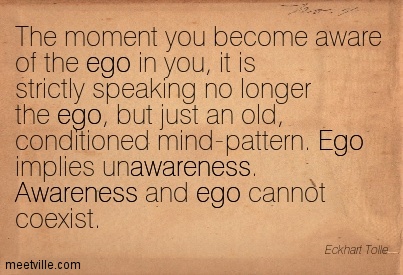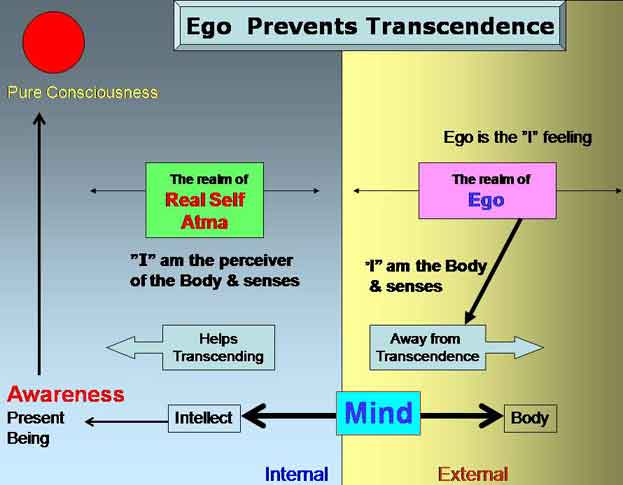Consciousness and Awareness
Consciousness and awareness – two words that sometimes are used interchangeably. Do they mean the same thing? If not, what is the difference between them?

Ego and Awareness
We commonly hear a story like – "the boy fell down, his head hitting a stone and he become unconscious. By the time the paramedics came, he had regained his consciousness and became slowly aware of the surroundings". Here, we notice that the boy had to regain consciousness to have awareness. Thus, these are two separate concepts. From the yoga perspective, consciousness is an attribute of the pure soul, called "Purusha" in the Yoga Sutras of Patanjali. Awareness is an attribute of the intellect which is a part of the phenomenal entity called "Prakriti".
As you may have heard, only Purusha or the soul (atman) has consciousness. That is why Purusha is often referred to as "pure consciousness". The intellect or the Prakriti has no consciousness of its own. It is the "borrowed" or reflected consciousness from the soul that the intellect uses for its working. Using this borrowed consciousness, the intellect becomes "aware" of the various elements of Prakriti.
Levels of awareness
So, what is awareness? Awareness is to bring any of the elements of prakriti into focus. According to the Sankhya philosophy, which forms the basis for Patanjali’s yoga philosophy, these elements are:
- intellect (buddhi)
- ego (ahankara)
- mind (manas)
- five sense perceptions – touch, smell, taste, sight and hearing
- five corresponding sense organs – skin, nose, tongue, eyes and ears
- five organs of action – feet and legs for locomotion, hands and arms for moving things around, organs of elimination, excretory organs and organ of speech (tongue)
- five great elements – earth, water, fire, air and ether.
Another way to look at awareness is to become aware of the five koshas (the five layers of existence). The five koshas are: Annamaya Kosha (physical level), Pranamaya Kosha (vital or the breath level), Manomaya Kosha (mental level), Vijnanamaya Kosha (intellectual and intuitive level), and Anandamaya Kosha (bliss level). When we are doing the yoga practice, we can easily bring awareness to the lower three levels listed above. By observing the signals and response from the various muscles, bones and limbs etc., we can become aware at the Annamaya Kosha level (physical). When we become aware of the breath, its quality, depth etc., we develop awareness at the Pranamaya Kosha. Similarly, when we become aware of our thoughts, feelings and emotions, we are developing awareness at the Manomaya Kosha level. Due to the influence of the ego, we are usually limited to the awareness at these lower three layers. Since the ego loves to work through the past samskaras (past impressions in our sub-conscious mind), we are unable to transcend the lower three koshas to get a glimpse of the deeper layers.
It is through a regular and continuous practice of yoga that we can learn how to minimize the influence of the ego so that we can connect with our own true innate wisdom represented by our intuition. Once we learn how to transcend the mind, we can enjoy the benefits of our intuitive wisdom and finally merge with the Anandamaya Kosha (total bliss).
Awareness is the same as being in the present moment
When we are aware, we are focused on the "now", what is happening at this very moment. For the most part, however, our ego plays its role in pulling us back into the past or dragging us into the future. When we are drawn into the past or the future, our actions and decisions are based on the whims of the ego. Which means the decisions and the actions are devoid of the pure intuitive wisdom and are thus flawed from the point of view of what is the most desirable. Decisions based on the ego always lead us into states of stress or anxiety or any of the other negative tendencies.
How to develop awareness

Ego and Consciousness
As mentioned earlier, awareness implies being in the present moment. We can start working on developing awareness through our yoga practices. Let us say, you are practicing the seated forward bending stretch called Pashchimottanasana. In this asana, we stretch the legs in front from the sitting position and make an attempt to drop the chest closer to the thighs. As we make an effort to go deeper into the pose, we want to be fully aware of any signals or messages that we receive from different parts of the body. If we have tight hamstrings, we want to "listen" to the hamstrings when deepening the stretch. We may have a stiff back and it may begin to complain. If at any point we get a signal indicating pain or discomfort, we want to take a step back and relax the pose slightly. With awareness we can maintain the asana practice safe and enjoyable.
Similarly, we want to maintain awareness of the breath even during the asana practice. For most of the asanas, we try to synchronize the movements with the appropriate breathing pattern. For example, we exhale while going into a forward bend and inhale while bending backwards. While trying to hold a pose, we want to keep awareness of both the body and the breath.
We cultivate awareness of the mind mostly while practicing pranayama (breathing) and meditation. For example, when we practice meditation, for the most part, the mind would like to drift away into its own thought streams. When that happens, we just want to stay aware of the thoughts but train ourselves not to get dragged with the thoughts away from the object of meditation. Awareness of the thoughts should involve no judgment or self-criticism. It is a pure observation of the thoughts with the intent of going back to the object of meditation as soon as we become aware of the encroaching thoughts.
Benefits of awareness
For the most part, we tend to react to people, situations and events. These reactions are based on impressions that are hidden deep in our sub-conscious levels. When confronted with a situation, our ego instantly brings up a mirror image of a similar event from the past and reacts instantly according to the previous impression. For example, let’s say we meet a person for the first time. The ego immediately tries to find a match from the memory. If the match shows that this person’s face resembles someone with whom we had a very unpleasant experience, our instant reaction is to try to avoid this person, without knowing anything about the person.
When we are aware, we are able to work from our pure intellectual wisdom and avoid the ego. As a result, rather than reacting, we are now able to respond intelligently. This obviously brings up many more possibilities for learning and growing.
When we are aware, we appreciate our own behavior patterns much better and are able to take appropriate steps to modify and improve our behavior. In general, awareness can bring about a general sense of happiness and contentment since we are not too concerned about the past or the future. Our relationships grow more meaningful and pleasant. As mentioned earlier, with awareness, we can eventually learn to transcend the limitations of the mind and get a closer look at our true self.
A deep state of awareness may ultimately bring us close to realizing that the true self is nothing but the "witnessing principle". As a witness, we are not involved with the "likes and dislikes", fears and phobias etc. that the ego would like to impose upon us. This can bring about an ultimate release from stress and anxiety, making the life a joyful journey.
Recent Comments